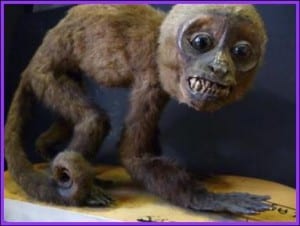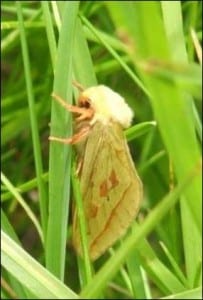Specimen of the Week: Week Fifty-Five
By Emma-Louise Nicholls, on 29 October 2012
 Many of you may not know Scary Monkey all that well, so let me tell you a little more about him. As his name suggests, Mr S. Monkey enjoys trying to scare people. His maniacal toothy grin does little to hide his mischievous personality (…monkey-nality?) It is no surprise therefore that Scary Monkey’s favourite time of year is not Christmas like most children, naughty or not. It’s not even his birthday, when he gets a special birthday dust. It is, you may have guessed by now, Halloween. Not having fully grasped the point, he says that tricks on you are treats for him, and on Halloween night, when there is a special, spooky, evening event at the Grant Museum, if you look closely you can sense a tiny vibration as he falters slightly in controlling his excitement. Halloween is said to have originated as an ancient Celtic festival, at which folk would set bonfires alight and (my favourite part) indulge in fancy dress. The costumes were intended to ward off roaming ghosts. Whilst we at the Grant don’t tend to wear fancy dress (often), we do, it just so happens, have our own ghost. In fact, we have several. Male and female. They are normally kept safely under lock and key but this week we have brought one out for you (we say you, we really mean to satiate Scary Monkey) and have put it on display in Case 9. See it while you can, for this week’s Specimen of the Week is…
Many of you may not know Scary Monkey all that well, so let me tell you a little more about him. As his name suggests, Mr S. Monkey enjoys trying to scare people. His maniacal toothy grin does little to hide his mischievous personality (…monkey-nality?) It is no surprise therefore that Scary Monkey’s favourite time of year is not Christmas like most children, naughty or not. It’s not even his birthday, when he gets a special birthday dust. It is, you may have guessed by now, Halloween. Not having fully grasped the point, he says that tricks on you are treats for him, and on Halloween night, when there is a special, spooky, evening event at the Grant Museum, if you look closely you can sense a tiny vibration as he falters slightly in controlling his excitement. Halloween is said to have originated as an ancient Celtic festival, at which folk would set bonfires alight and (my favourite part) indulge in fancy dress. The costumes were intended to ward off roaming ghosts. Whilst we at the Grant don’t tend to wear fancy dress (often), we do, it just so happens, have our own ghost. In fact, we have several. Male and female. They are normally kept safely under lock and key but this week we have brought one out for you (we say you, we really mean to satiate Scary Monkey) and have put it on display in Case 9. See it while you can, for this week’s Specimen of the Week is…
**The Ghost Moth**
1) The scientific name of the ghost moth refers to a mythical creature in Norse and Germanic legend and means ‘invisible ghost’. Wooooo. It is thought that, on a dark and spooky night, a swarm of these pale coloured moths produces a shimmering impression of a human ghostly figure, particularly when the pulsating mass of insects is gathered vertically up a tree trunk.
2) The ghost moth is native to the UK and Europe and is one of the largest micro-moths in Europe, with females reaching up to 8 cm in wingspan. Females can be identified by a series of pale pink markings on the forewing. Ahhh. They are also slightly bigger than the males but unless you happen to have one of either sex side by side and know that they are both at the same stage of growth, then that probably won’t help you, and if you are in that situation, you are probably a specialist with an intimate knowledge of moths anyway.
3) Like a strange Frankensteinian monster experiment gone wrong, adult ghost moths lack functional mouthparts, and subsequently, they cannot feed. I can hear the Strange But True music. Loved that programme. Halloween is celebrated a few months early in moth world, and so you can only see ghost moths flying around between June and July. With no way to eat, they do not, of course, last long- before they form SWARMS OF ZOMBIE-FIED HERETICS THAT SUCK ON THE BRAINS OF BABY ANIMALS. Ok that last part wasn’t entirely true.
4) It is down to the male to provide the romance in ghost moth land. They emit pheromones from large tufts of hair located on their hind legs, that produce a charming (I guess) perfume. They waft the scent around during a slow aerial display of hovering, and pendulating flight patterns. They shun the usual night-club hang outs when trying to pick up a girl, choosing instead to court either low over vegetation, or up and down in front of a tree trunk, a bit like a pole dancer. As with human men in a bar, the typical ghost moth male requires a wing-man, or several hundred in their case, and perform their dance in all male swarms that have on rare occasions, been found to number thousands of individuals.
5) Ghost moths produce eggs that are oval in shape and shining white in colour, as you may expect from a ghostly creature. Starting life with a bump, the eggs are dropped by the female whilst she is in flight. Fortunately, she also lays a very large number, presumably to compensate for her lack of delicacy. The larvae that pop out of the eggs, spend eight months developing in tunnels in the soil, where they feed on vegetation. As in any half decent horror flick with abominations rising from the dead, the pupa hatches in the tunnel and then crawls to the surface where the adult is ready to spring out.
If neither ghost moths nor Scary Monkey himself can put you off, venture timidly or boldly as you so desire, to our special Halloween event on Wednesday evening and calm your nerves with a glass of wine…
Emma-Louise Nicholls is the Museum Assistant at the Grant Museum of Zoology
One Response to “Specimen of the Week: Week Fifty-Five”
- 1
 Close
Close





Love scary monkey and I look forward to introducing him(?) to my children soon. I will add him to my list of best animal exhibits up there with the jar of moles and the natural history Museum’s owl with a pencil in its ear. Yours enjoying the blog Steve k